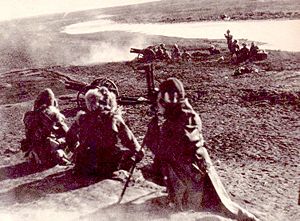- Chinchow Operation
-
The Chinchow Operation was an operation during the invasion of Manchuria as part of the campaign of the Invasion of Manchuria by forces of the Empire of Japan in the early stages of the Second Sino-Japanese War.
Contents
Background
In late November 1931, Imperial Japanese Army commander in chief General Shigeru Honjō dispatched 10,000 soldiers in 13 armored trains, escorted by a squadron of bombers, in an advance on Chinchow from Mukden. This force advanced to within 30 kilometers of Chinchow when it received an order to withdraw. The operation was cancelled by Japanese War Minister General Jirō Minami, due to the acceptance of modified form of a League of Nations proposal for a "neutral zone" to be established as a buffer zone between the Republic of China proper and Manchuria pending a future China-Japanese peace conference by the civilian government of Prime Minister Wakatsuki Reijirō in Tokyo.
However the two sides failed to reach a lasting agreement. The Wakatsuki government soon fell and was replaced by a new cabinet led by Prime Minister Tsuyoshi Inukai. Further negotiations with the Kuomintang government failing, the Japanese government approved an increase in the military forces in Manchuria. In December, the rest of 20th Infantry Division, along with 38th Mixed Brigade from 19th Infantry Division were sent into Manchuria from Korea while the 8th Mixed Brigade from the 10th Infantry Division was sent from Japan.
Following the defeat of General Ma Zhanshan in Heilongjiang province, and anticipating obtaining new reinforcements, a new Japanese offensive was launched in Manchuria on December 21. General Honjo insisted his troops were moving out "to clear the country of bandits," and added that Chinese evacuation of Chinchow "is now absolutely imperative." Most of the "bandits" were actually the organizing Anti-Japanese Volunteer Armies but some real bandits were also exploiting the chaos following the collapse of the Chinese government and its Northeastern Army following the Mukden Incident and Japanese invasion of Manchuria.
Start of the Chinchow Operation
While the other Japanese forces and collaborationist Manchurian troops spread out from their bases along the South Manchurian Railway rail lines to clear the countryside, from Mukden, the Japanese headquarters in Manchuria, the brigades of the 12th Infantry Division advanced southward in the night, supported by squadrons of Japanese bombers to force the Chinese to evacuate Chinchow.
The Japanese estimated the Chinese at Chinchow had 84,000 defenders, with 58 artillery pieces placed to support two separate systems of entrenchments defending the city. The Chinese first defensive line, 20 miles north of the city, was a series of trenches aimed to stop the Japanese advance at the Taling River Bridge on the Peiping-Mukden Railway. The Chinese had a second line of earthworks and entrenchments completely encircling Chinchow to fall back on if the Japanese forces broke through the first line.
Japanese Lieutenant General Jirō Tamon's troops cautiously advanced south from Mukden. The temperature was 30 below zero, and Japanese forces were camouflaged in long white gowns. Japanese reconnaissance aircraft reported a force of at least 3,000 Chinese "bandits" waiting to defend Panshanhsien. Brushing aside these Chinese skirmishers in a series of minor clashes, Tamon prepared to meet and crush the first serious Chinese resistance, expected at Kowpangtze, 50 kilometers north of Chinchow.
By the evening of December 31, 1931, the Japanese advance guard was fifteen kilometers from Chinchow on the banks of the Taling river. General Tamon halted briefly to bring up the rest of his 2nd Division, for the final drive on Chinchow. The Japanese War Office announced a radio broadcast of "The Battle of the Taling River", setting up microphones behind the Japanese lines, arranging an elaborate hookup to broadcast the sound of firing to Tokyo, but then had to call off the broadcast when the Chinese retreated without giving combat.
Japanese forces occupied Chinchow on January 3, 1932, with the local populace waving Japanese flags homemade during the night to appease the conquerors.
Aftermath
On the Chinese side confusion reigned. The old government of Chang Kai-shek at Nanking had resigned and a new one under Premier Sun Fo had been formed. Additionally, Marshal Zhang Xueliang's defenders were in disorderly retreat toward the Great Wall, leaving only a small garrison to protect the few government functionaries who remained behind. At Nanking Eugene Chen, the new Kuomingtang Foreign Minister, asserted that his government had never ordered evacuation of Chinchow, but, on the contrary, had ordered Marshal Zhang repeatedly to stand his ground. Nine Chinese generals in various parts of China denounced Premier Sun Fo's new government, blaming it for the humiliating loss of Chinchow without a struggle.
The day after the fall of Chinchow, the Imperial Japanese Army occupied Shanhaiguan, thus completing its military control over south Manchuria.
See also
- Japanese invasion of Manchuria
- Pacification of Manchukuo
References
- Coogan, Anthony (1994). Northeast China and the Origins of the Anti-Japanese United Front. Modern China, Vol. 20, No. 3 (Jul., 1994), pp. 282-314: Sage Publications.
- Matsusaka, Yoshihisa Tak (2003). The Making of Japanese Manchuria, 1904-1932. Harvard University Asia Center. isbn = 0674012062.
External links
Categories:- Battles of the Second Sino-Japanese War
- Conflicts in 1931
- Conflicts in 1932
- 1931 in China
- History of Manchuria
- 1931 in Japan
- 1932 in Japan
Wikimedia Foundation. 2010.

